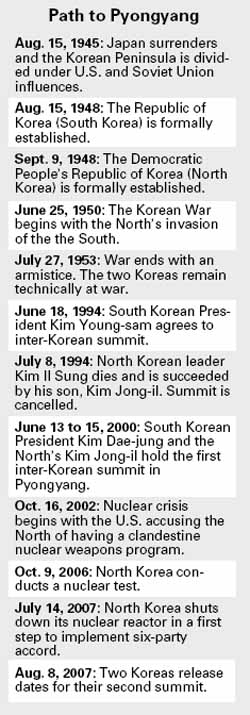To promote reconciliation on the divided peninsula.

Former South Korean President Kim Dae-jung, left, and North Korean leader Kim Jong-il in Pyongyang before signing a joint declaration on June 15, 2000. [JoongAng Ilbo]
Scheduling a summit meeting is never easy, but arranging one between the two Koreas, who are technically still at war, is particularly challenging. The upcoming summit will be only the second in the half-century history of the national division of Korea.
The defeat of the Japanese in World War II brought independence to Korea in 1945, but the peninsula was quickly divided under the influence of the United States and the Soviet Union. On Aug. 15, 1948, South Korea, formally known as the Republic of Korea, was established. On Sept. 9 of the same year, North Korea, or the Democratic People’s Republic of Korea, was formally founded.
After the 1950-53 Korean War ended with an armistice, tension between the two Koreas fluctuated through the years, but efforts to bring peace on the Korean Peninsula continued.
Pressures reached a new peak in 1994 after North Korea’s nuclear ambitions became an international issue. While Washington considered military action, former U.S. President Jimmy Carter visited Pyongyang in June. After Carter’s visit, the United States and North Korea put a temporary end to the nuclear crisis by signing an agreement. An inter-Korean summit was also planned to reduce tensions.
On June 18, 1994, then-South Korean President Kim Young-sam agreed to an inter-Korean summit with Kim Il Sung, the founding leader of North Korea. The planned summit, however, was never realized because of the North Korean leader’s sudden death on July 8, 1994. He was succeeded by his son, Kim Jong-il.

Inter-Korean relations saw little progress after the summit plan fell through, but the succeeding Kim Dae-jung administration in the South renewed efforts for a meeting of the leaders of the North and South. On March 9, 2000, in a speech in Berlin, Kim made public his administration’s engagement policy toward Pyongyang. In the Berlin Declaration, Kim proposed a government-level inter-Korean dialogue, adding that Seoul was ready to provide economic assistance to the North.
The North responded willingly, and Kim’s key aides secretly met with North Korean officials to arrange the first-ever inter-Korean summit. A series of meetings took place in China and an agreement to hold the summit was reached on April 8, 2000.
The historic summit between then-South Korean President Kim Dae-jung and North Korea’s National Defense Commission Chairman, Kim Jong-il, took place in June 2000.
The process of getting to the summit, however, was not easy or transparent. The two sides originally agreed to hold the meeting in Pyongyang from June 12 to 14, but the schedule was postponed by one day at the North’s request, only two days before the agreed meeting day.
Pyongyang asked to delay the summit for one day for “technical preparation.” A South Korean independent counsel investigation later revealed that the delay was caused by a slow money transfer. South Korea agreed to pay cash in return for the summit, but the money transfer was delayed, and in protest, Pyongyang refused to hold the summit as scheduled, the probe later found.
South Korea managed to pay the North only on the eve of the summit. Park Jie-won, a key aide to Kim Dae-jung, asked Hyundai Asan to send $450 million to the North, and the summit finally took place from June 13 to 15.
At the end of the summit, the two leaders issued a declaration to promote peace and cooperation on the peninsula.
Despite the efforts for inter-Korean peace, tensions on the Korean Peninsula escalated again after Washington accused Pyongyang of having a clandestine nuclear weapons program in 2002. The situation grew even worse as North Korea conducted a nuclear test on Oct. 9, 2006.
Six-party talks among the two Koreas, China, Japan, Russia and the United States were initiated, but little progress was seen in ending the North’s nuclear arms program.
In 2007, efforts for another inter-Korean summit were renewed. Earlier this month, Kim Man-bok, South Korea’s intelligence chief, visited Pyongyang secretly, and the two sides agreed to hold the second inter-Korean summit later this month, in Pyongyang.
The Blue House announced on Aug. 8 that a summit will be held on Aug. 28 to 30. “The second South-North Korean summit will not only help resolve the North Korean nuclear issue, but also enhance inter-Korean ties,” a statement from the presidential office said. Although Kim Jong-il had promised in 2000 that he would pay a reciprocal visit to South Korea at an appropriate time, the South Korean president will again travel to the North for the summit. The two Koreas agreed that Roh will travel by road to Pyongyang.
However, a national emergency from recent floods in North Korea set back the plan. Citing serious flood damage, North Korea officially asked on Aug. 18 to postpone the summit.
The two Koreas have agreed to a new date ― the summit is now scheduled for Oct. 2 to 4.
By Ser Myo-ja Staff Writer [myoja@joongang.co.kr]










with the Korea JoongAng Daily
To write comments, please log in to one of the accounts.
Standards Board Policy (0/250자)